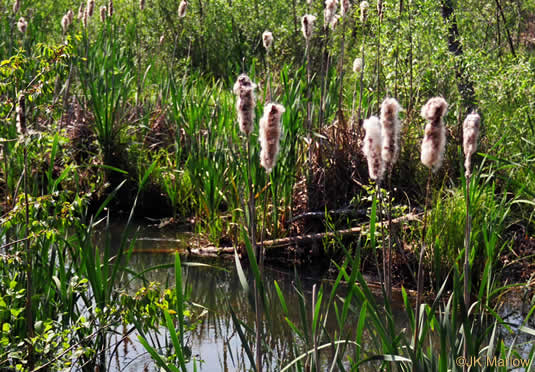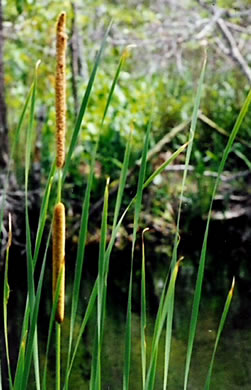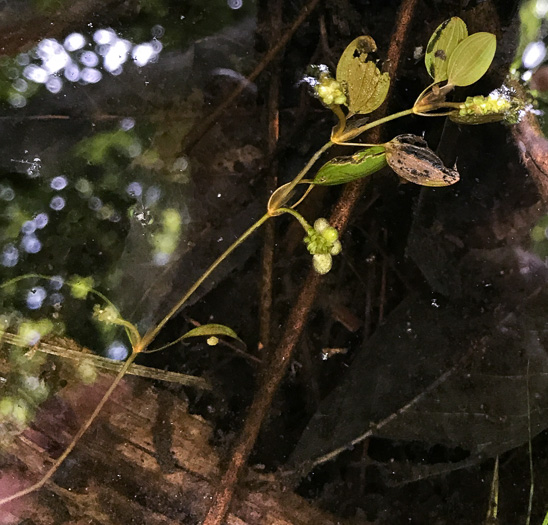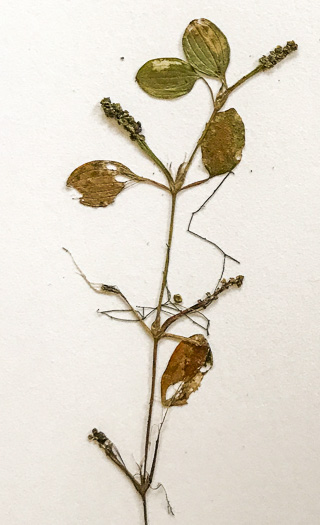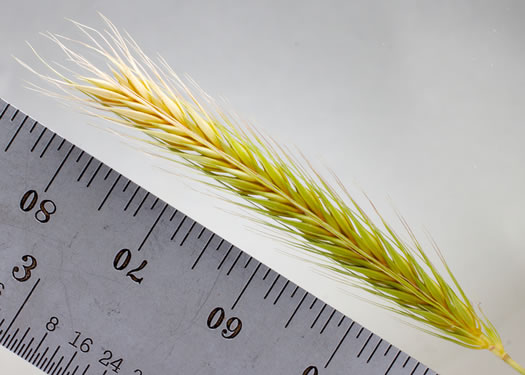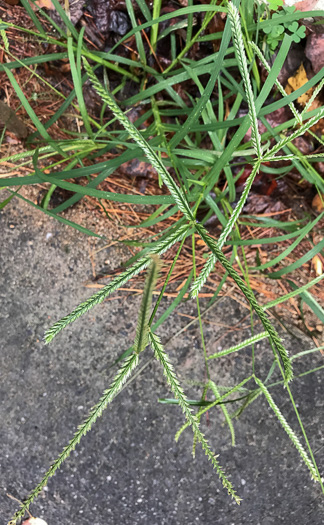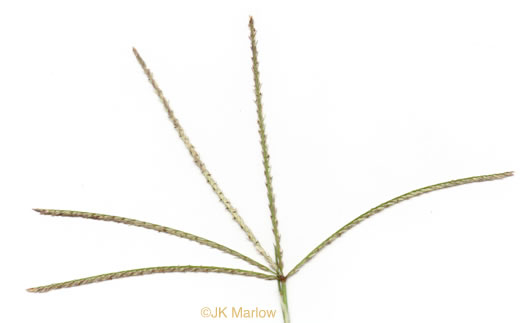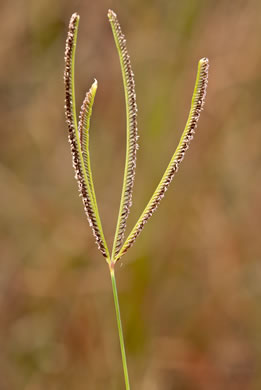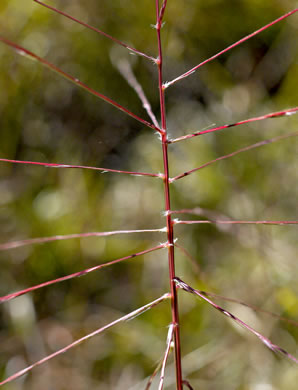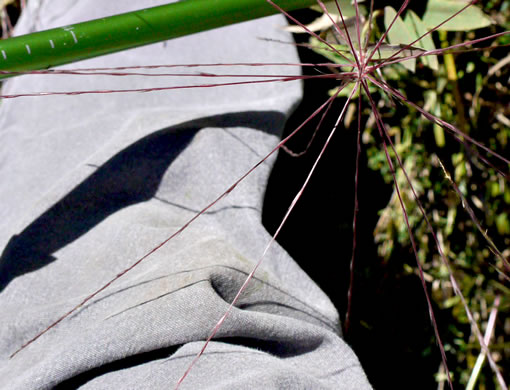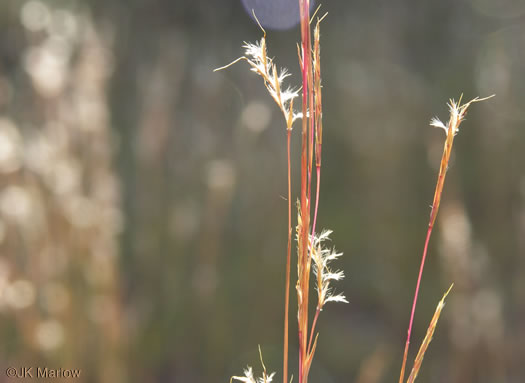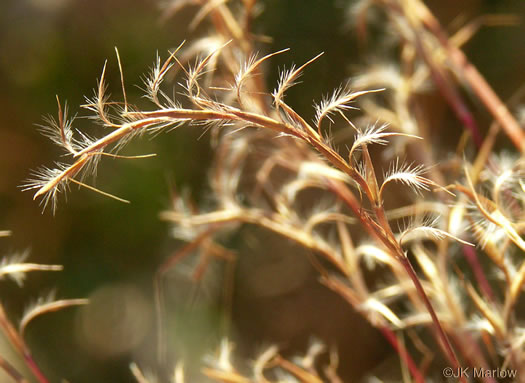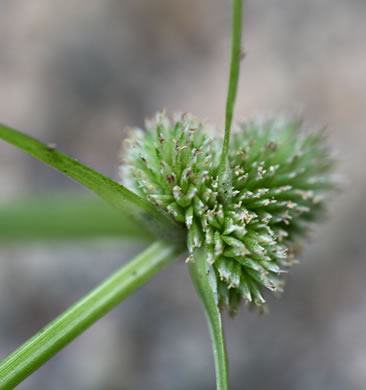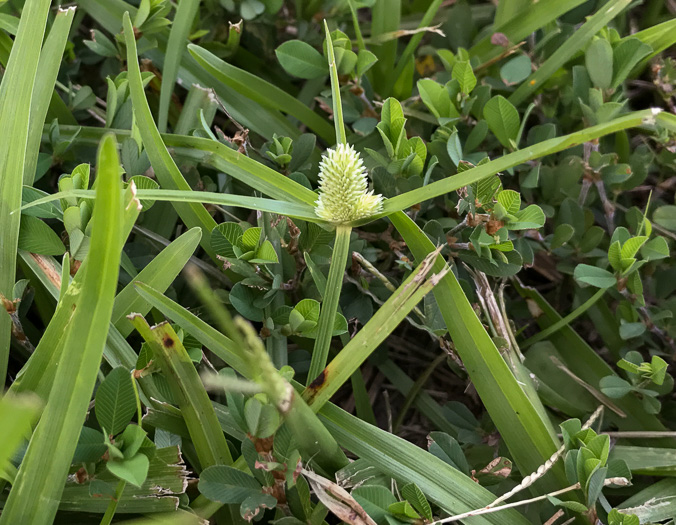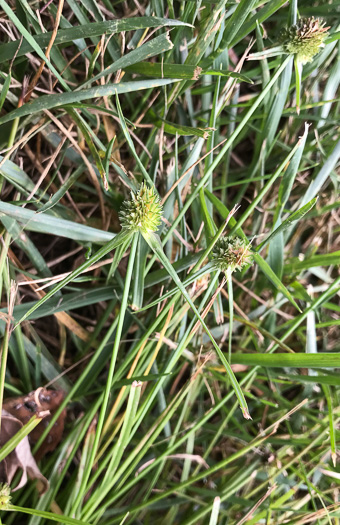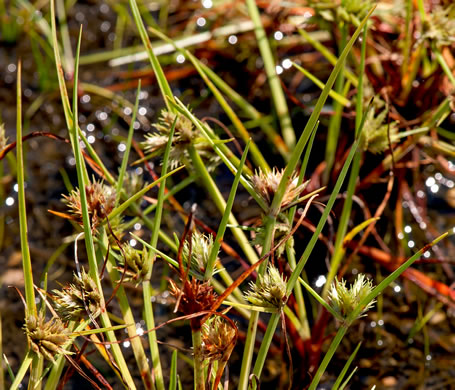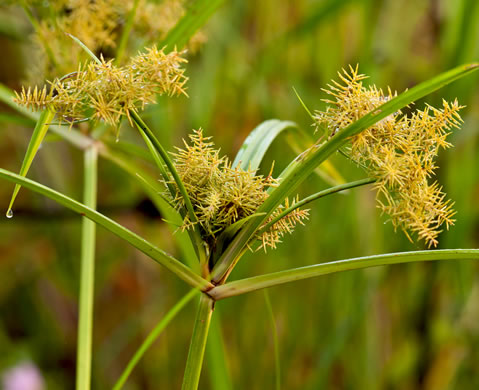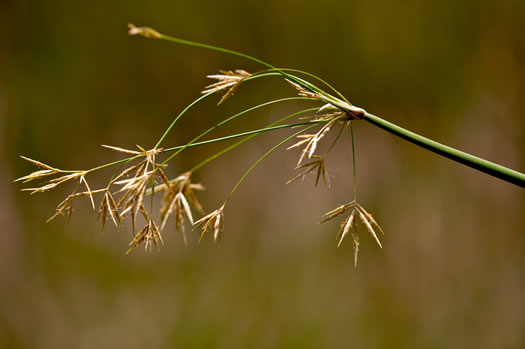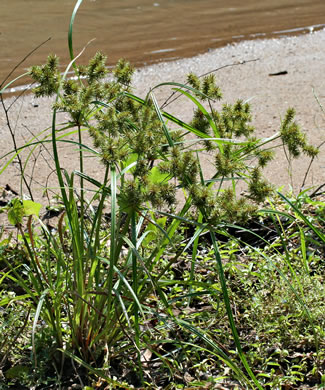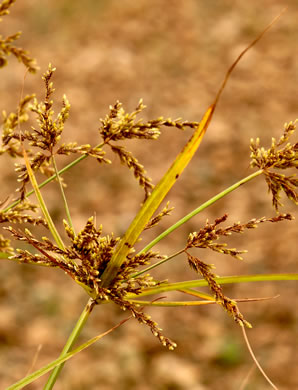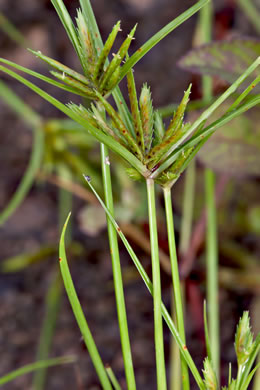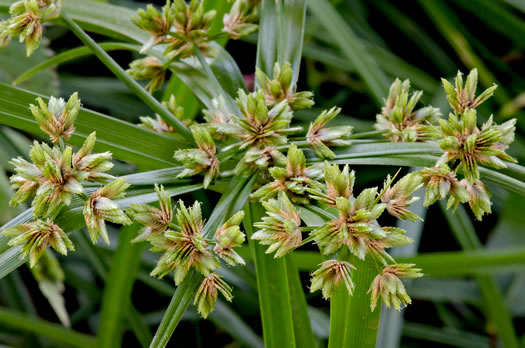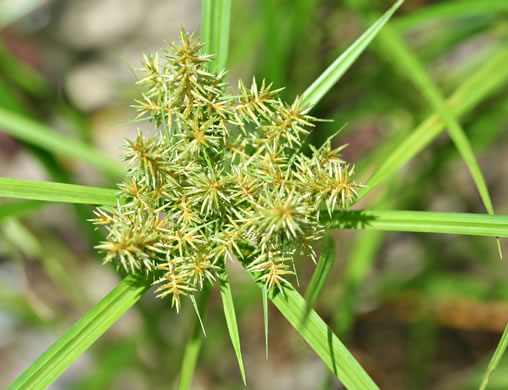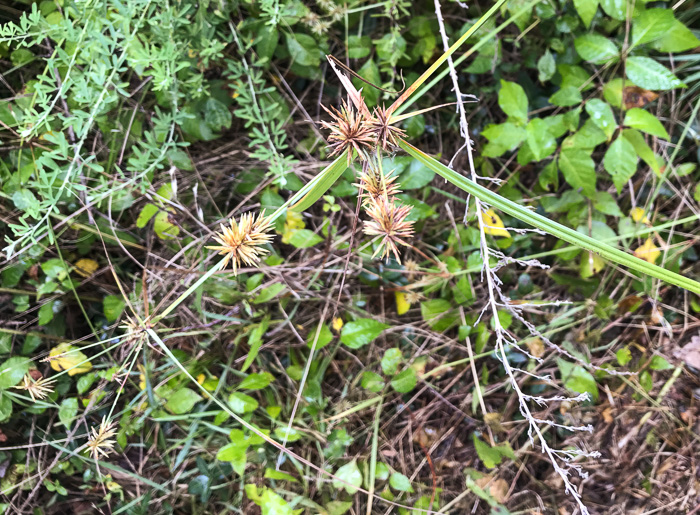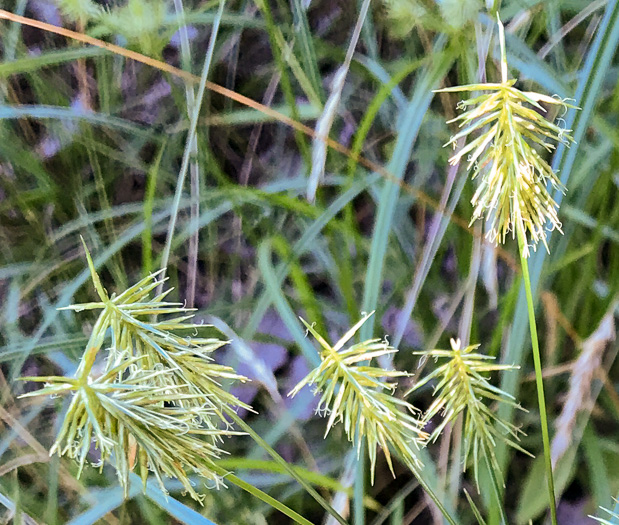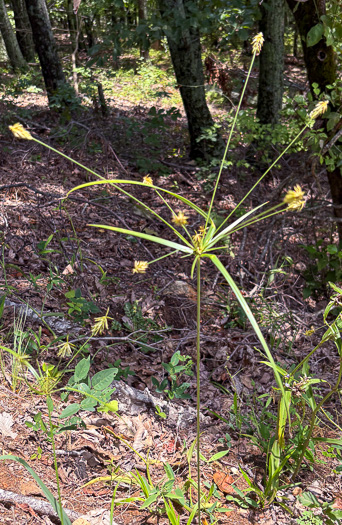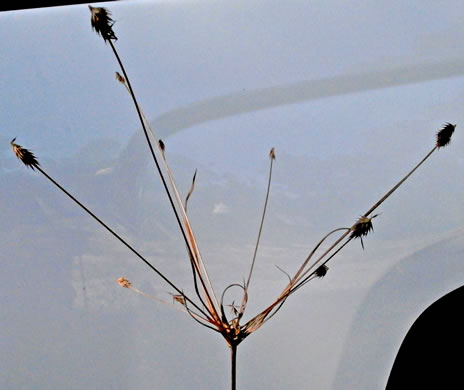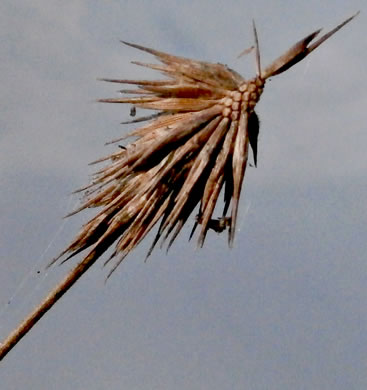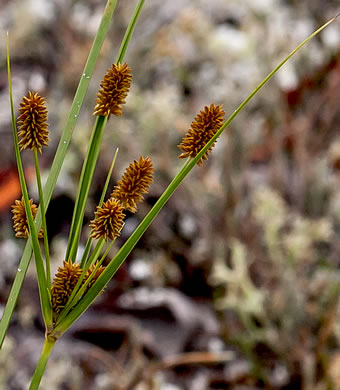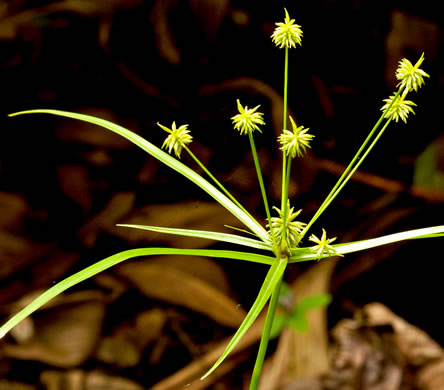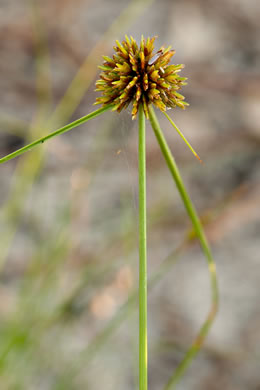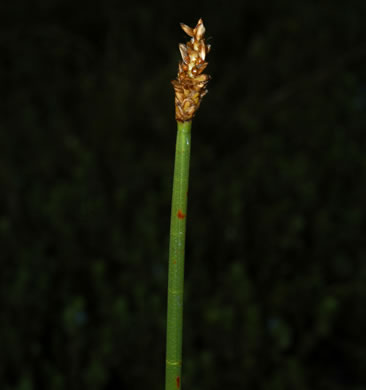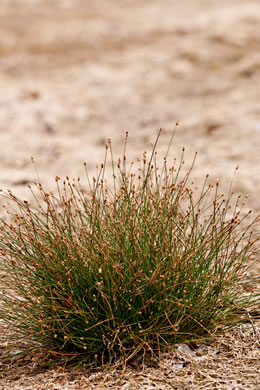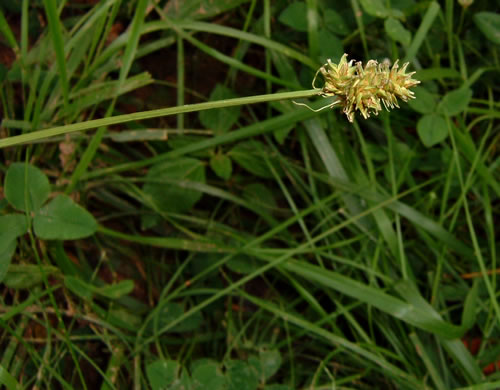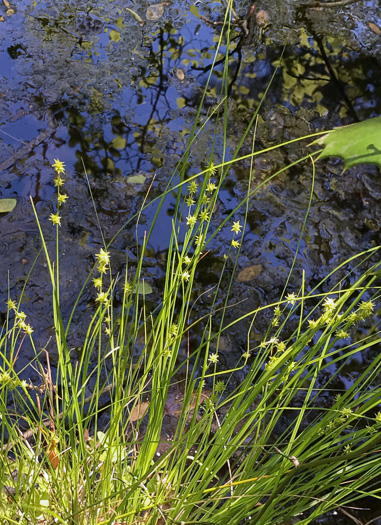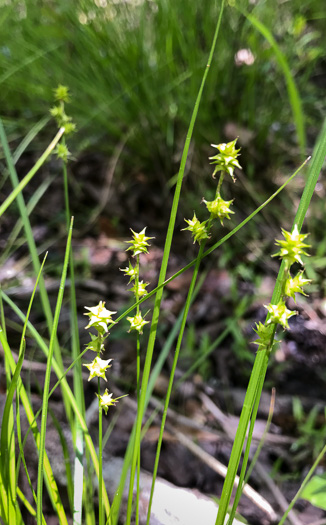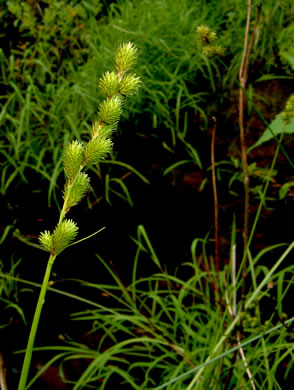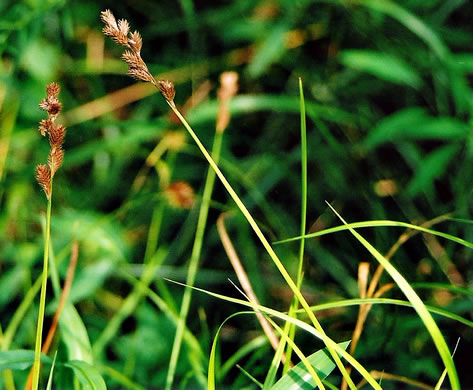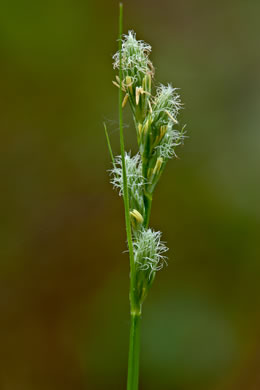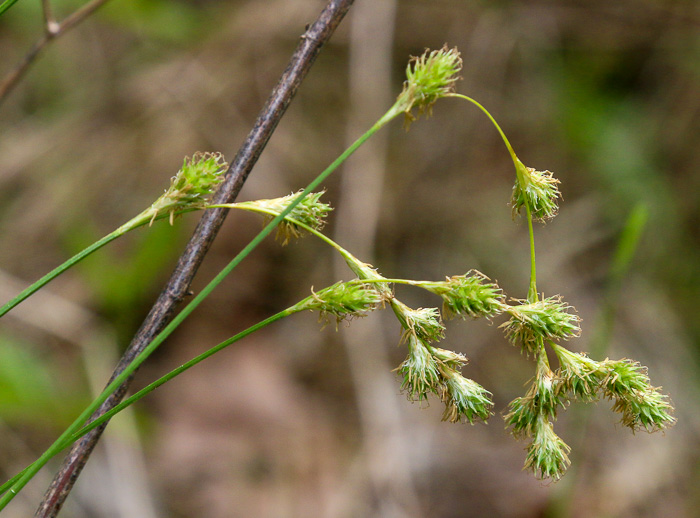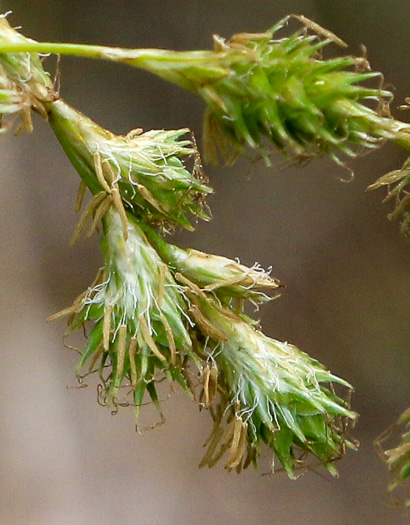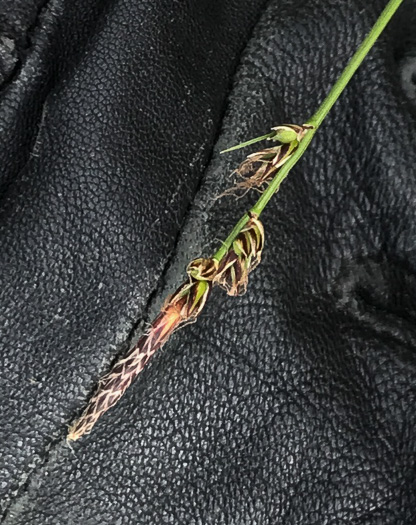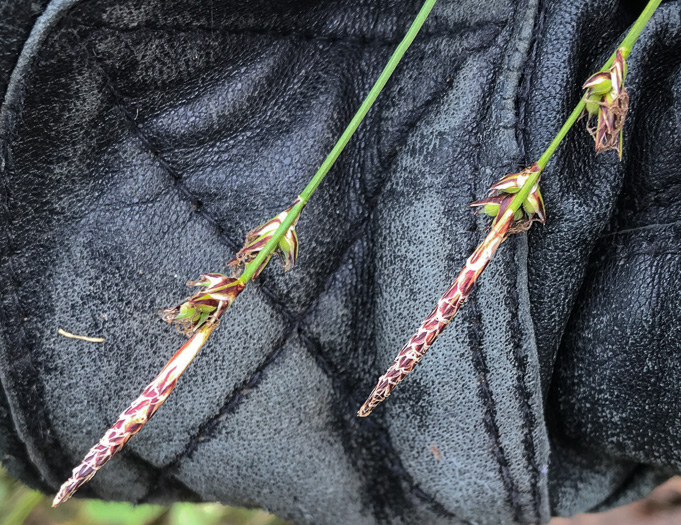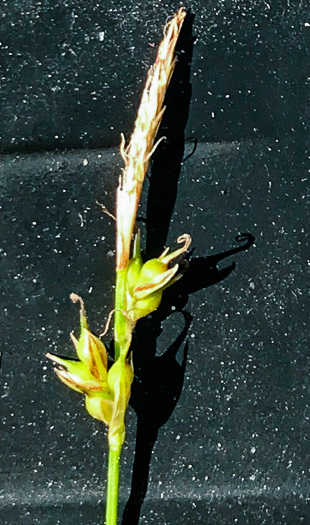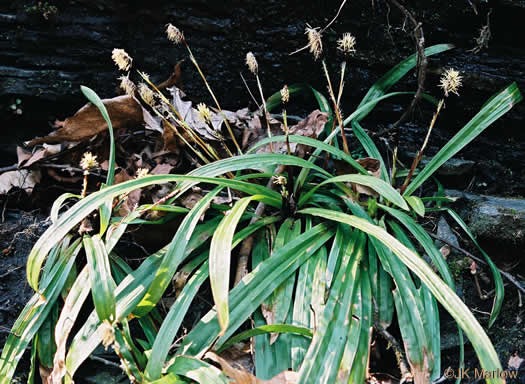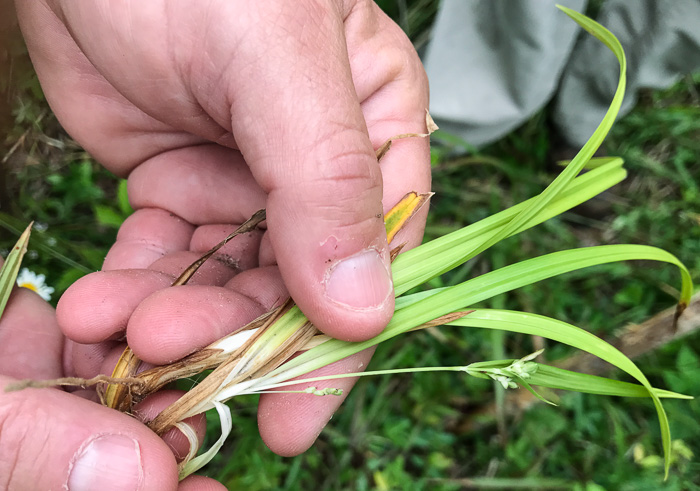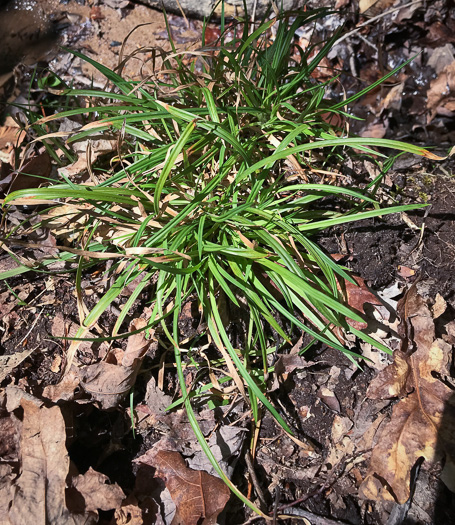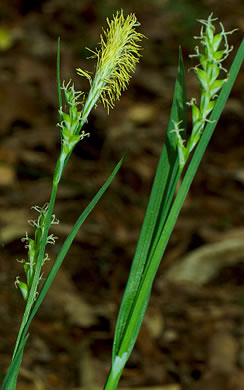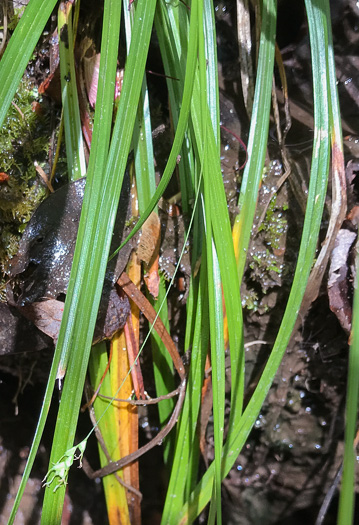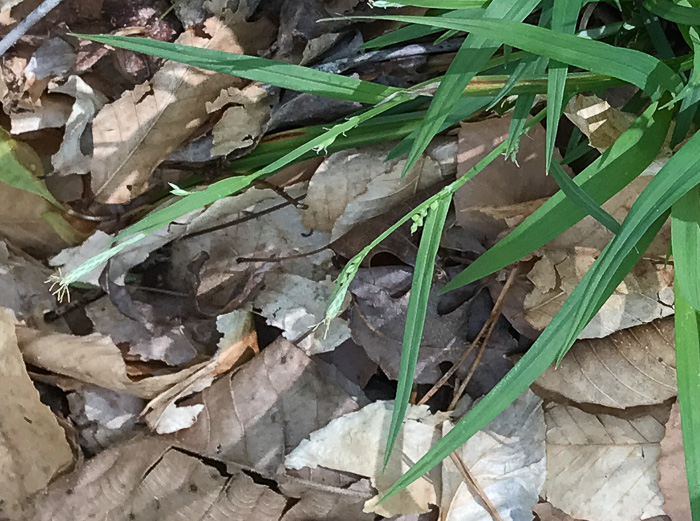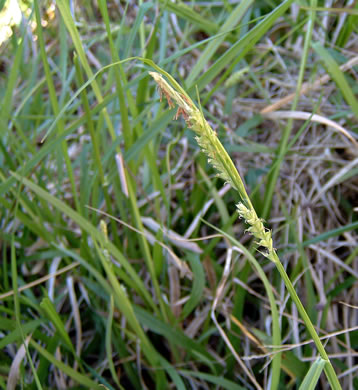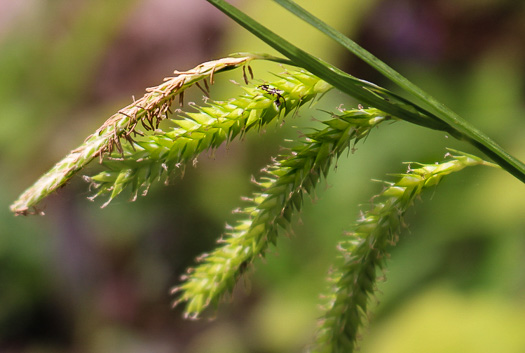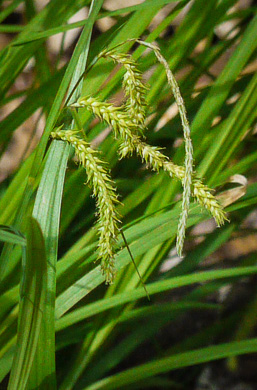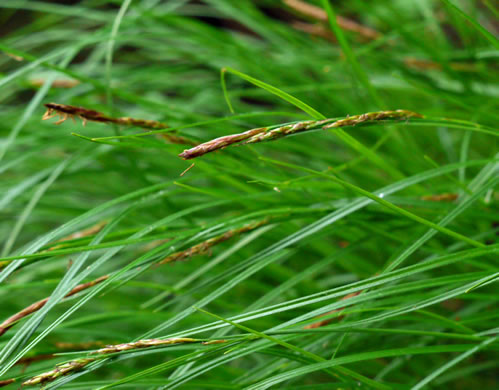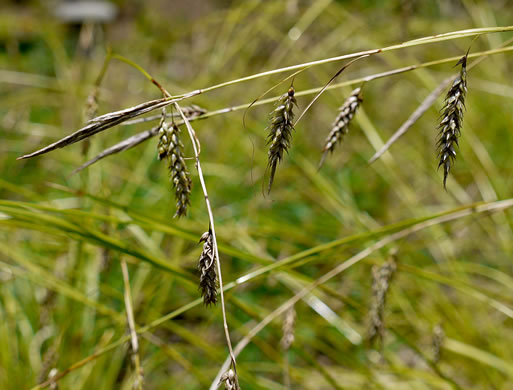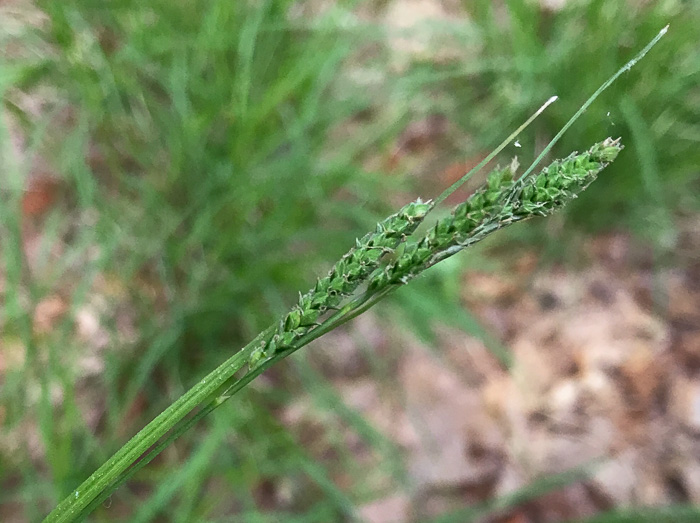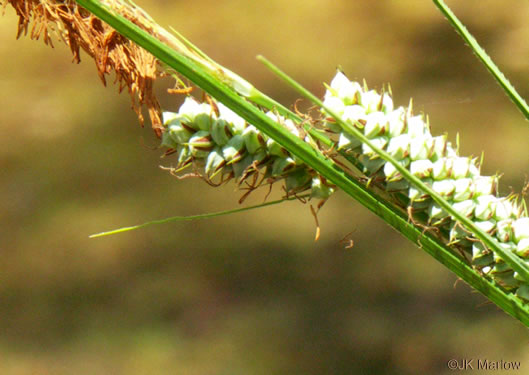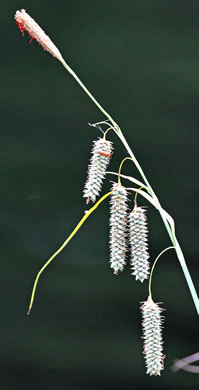Your search found 132 image(s) illustrating the term "spikes." For a written explanation, click on "spikes" in the Glossary.
To see larger pictures, click or hover over the thumbnails.
To go to the plant's detail page, click its name.
 Common Cattail,
Typha latifolia
Common Cattail,
Typha latifolia
Fuzzy, brown cylindric spikes (cattails) persist into winter, per Wildflowers of Tennessee, the Ohio Valley, and the Southern Appalachians (Horn, Cathcart, Hemmerly, & Duhl, 2005).
 Narrowleaf Cattail,
Typha angustifolia
Narrowleaf Cattail,
Typha angustifolia
Its male and female flower spikes are separated by naked stem, per Atlantic Coastal Plain Wildflowers (Nelson, 2006).
 Common Snailseed Pondweed,
Potamogeton diversifolius
Common Snailseed Pondweed,
Potamogeton diversifolius
Fruiting spikes cylindric, 3-20mm long, 3-6mm broad; peduncles to 7cm long, per Vascular Flora of the Carolinas (Radford, Ahles, & Bell, 1968).
 Common Snailseed Pondweed,
Potamogeton diversifolius
Common Snailseed Pondweed,
Potamogeton diversifolius
Infl's unbranched; spikes dimorphic: submersed capitate & 2-3mm, emersed cylindric & 5-9.7mm, per Flora of North America.
 Little Barley,
Hordeum pusillum
Little Barley,
Hordeum pusillum
Spikes 2-8cm long, 5-7mm broad, per Vascular Flora of the Carolinas (Radford, Ahles, & Bell, 1968).
 Goosegrass,
Eleusine indica
Goosegrass,
Eleusine indica
Spikelets in 2 rows on one side of spikes, lemmas and glumes awnless, per Wildflowers of the Eastern United States (Duncan & Duncan, 1999).
 Bermuda Grass,
Cynodon dactylon
Bermuda Grass,
Cynodon dactylon
Several slender spikes digitate at the summit of the upright culms, per Manual of the Grasses of the United States (Hitchcock & Chase, 1950).
 Dune Fingergrass,
Eustachys petraea
Dune Fingergrass,
Eustachys petraea
3-6 spikes arise at about the same point at stem end. Stems often decumbent, per Wildflowers of the Eastern United States (Duncan & Duncan, 1999).
 Eastern Skeletongrass,
Gymnopogon ambiguus
Eastern Skeletongrass,
Gymnopogon ambiguus
Long slender divergent or reflexed spikes set close on a slender stiff axis, per Manual of the Grasses of the United States (Hitchcock & Chase, 1950).
 Eastern Skeletongrass,
Gymnopogon ambiguus
Eastern Skeletongrass,
Gymnopogon ambiguus
Spikes 10-20cm long, per Manual of the Grasses of the United States (Hitchcock & Chase, 1950).
 Common Little Bluestem,
Schizachyrium scoparium
Common Little Bluestem,
Schizachyrium scoparium
Flower spikes are solitary from long stalks at intervals along the stem, per Wildflowers of the Sandhills Region (Sorrie, 2011).
 Common Little Bluestem,
Schizachyrium scoparium
Common Little Bluestem,
Schizachyrium scoparium
Schizachyrium's spikes not split into two racemes, like those of Andropogon, per Wildflowers of the Sandhills Region (Sorrie, 2011).
 Annual Greenhead Sedge,
Cyperus hortensis
Annual Greenhead Sedge,
Cyperus hortensis
Spikes 1-3, greenish, cylindric to subglobose, sessile, per Vascular Flora of the Carolinas (Radford, Ahles, & Bell, 1968).
 Whitehead Sedge,
Cyperus sesquiflorus
Whitehead Sedge,
Cyperus sesquiflorus
1-3(4) ovoid to ellipsoid whitish spikes subtended by (2)3-4 horizontal bracts, per Flora of North America.
 Crested Greenhead Sedge,
Cyperus metzii
Crested Greenhead Sedge,
Cyperus metzii
Inflorescences of former Kyliinga spp. are unbranched (the spikes sessile), per Weakley's Flora (2020).
 Granite Flatsedge,
Cyperus granitophilus
Granite Flatsedge,
Cyperus granitophilus
Spikes congested, subglobose. Bracts 2-5, 1-8cm long, 1-2mm wide, per Vascular Flora of the Carolinas (Radford, Ahles, & Bell, 1968).
 Fragrant Flatsedge,
Cyperus odoratus
Fragrant Flatsedge,
Cyperus odoratus
Bracts numerous, 3-7mm wide. Spikes numerous, congested, loosely cylindric, per Vascular Flora of the Carolinas (Radford, Ahles, & Bell, 1968).
 jointed flatsedge,
Cyperus articulatus
jointed flatsedge,
Cyperus articulatus
Spikes usually numerous, congested, appearing as irregular clusters, per Vascular Flora of the Carolinas (Radford, Ahles, & Bell, 1968).
 Redroot Flatsedge,
Cyperus erythrorhizos
Redroot Flatsedge,
Cyperus erythrorhizos
Spikes numerous, congested, cylindrical. Central sessile, lateral rays unequal, per Vascular Flora of the Carolinas (Radford, Ahles, & Bell, 1968).
 Rice-field Flatsedge,
Cyperus iria
Rice-field Flatsedge,
Cyperus iria
Spikes numerous in irregularly ascending, umbellate clusters, per Vascular Flora of the Carolinas (Radford, Ahles, & Bell, 1968).
 Poorland Flatsedge,
Cyperus compressus
Poorland Flatsedge,
Cyperus compressus
Spikes 1-6, in subglobose clusters. Peduncles to 10cm long, per Vascular Flora of the Carolinas (Radford, Ahles, & Bell, 1968).
 Green Flatsedge,
Cyperus virens
Green Flatsedge,
Cyperus virens
Spikes numerous in congested umbellate clusters. Spikelets digitate, per Vascular Flora of the Carolinas (Radford, Ahles, & Bell, 1968).
 False Nutsedge,
Cyperus strigosus var. strigosus
False Nutsedge,
Cyperus strigosus var. strigosus
Spikes 5-10 or more, congested or open, narrowly to broadly cylindric, per Vascular Flora of the Carolinas (Radford, Ahles, & Bell, 1968).
 Many-flowered Flatsedge,
Cyperus lancastriensis
Many-flowered Flatsedge,
Cyperus lancastriensis
Leaves and inf. bracts mostly >10mm wide. Spikes dense; spikelets subterete, per Weakley's Flora (2020).
 Rough Flatsedge,
Cyperus retrofractus
Rough Flatsedge,
Cyperus retrofractus
Spikes strongly narrowed to the base; all but the uppermost spikelets strongly reflexed, per Weakley's Flora (2023).
 Rough Flatsedge,
Cyperus retrofractus
Rough Flatsedge,
Cyperus retrofractus
The 4-13 spikes are ob-cylindrical (widest at tip) and occur at the ends of very long stalks, per Vascular Plants of North Carolina.
 Starburst Flatsedge,
Cyperus plukenetii
Starburst Flatsedge,
Cyperus plukenetii
Rays scabrid [rough]; longest ray ≥ longest bract; spikes tight, burlike, turbinate [top-shaped], per Weakley's Flora (2023).
 Starburst Flatsedge,
Cyperus plukenetii
Starburst Flatsedge,
Cyperus plukenetii
Spikes strongly obovate, composed of many sharp, backward-oriented scales, per Wildflowers of the Sandhills Region (Sorrie, 2011).
 Pineland Flatsedge,
Cyperus retrorsus
Pineland Flatsedge,
Cyperus retrorsus
Spikes cylindric or subcylindric, less than 1cm broad, less than 3x as long, per Vascular Flora of the Carolinas (Radford, Ahles, & Bell, 1968).
 Baldwin's Flatsedge,
Cyperus croceus
Baldwin's Flatsedge,
Cyperus croceus
Spikes subglobose, dense, 5-20mm broad, per Vascular Flora of the Carolinas (Radford, Ahles, & Bell, 1968).
 Southeastern Flatsedge,
Cyperus filiculmis
Southeastern Flatsedge,
Cyperus filiculmis
Spikes subglobose, 5-30mm broad, per Vascular Flora of the Carolinas (Radford, Ahles, & Bell, 1968).
 Horsetail Spikerush,
Eleocharis equisetoides
Horsetail Spikerush,
Eleocharis equisetoides
Spikes many-flowered, not wider than stem; stem knotted or jointed, per Field Guide to the Grasses, Sedges & Rushes of the US (Knobel, 1899) (Faust, 1977).
 Canada spikesedge,
Eleocharis geniculata
Canada spikesedge,
Eleocharis geniculata
Spikes ovoid to subglobose; achene body 0.7-1.0 mm long, per Weakley's Flora (2015).
 Oval-leaf Sedge,
Carex cephalophora
Oval-leaf Sedge,
Carex cephalophora
Terminal dense spikes w female flowers protruding outward in all directions, per Forest Plants of the Southeast and Their Wildlife Uses (Miller & Miller, 2005).
 Prickly Bog Sedge,
Carex atlantica
Prickly Bog Sedge,
Carex atlantica
Leaf blades 1.5-3mm wide. Spikes more than 1 per culm, per Vascular Flora of the Carolinas (Radford, Ahles, & Bell, 1968).
 Prickly Bog Sedge,
Carex atlantica
Prickly Bog Sedge,
Carex atlantica
Spikes mostly uniform, sessile. Perigynia broadly ovoid, spreading, per Vascular Flora of the Carolinas (Radford, Ahles, & Bell, 1968).
 Blunt Broom Sedge,
Carex tribuloides
Blunt Broom Sedge,
Carex tribuloides
Inflorescences straight and stiff, the lower spikes overlapping, per Weakley's Flora (2012).
 Blunt Broom Sedge,
Carex tribuloides
Blunt Broom Sedge,
Carex tribuloides
Spikes 6-15, overlapping or distinct, ovoid-oblong to globose, per Flora of North America.
 Long's Sedge,
Carex longii
Long's Sedge,
Carex longii
Inflorescences erect, 1-4.5cm long; spikes slightly separated to congested, per Weakley's Flora (2015).
 Slender Sedge,
Carex tenera
Slender Sedge,
Carex tenera
Inflorescences often flexible and nodding, open, w elongate spikes; rachis usually thin and wiry, per Flora of North America.
 Slender Sedge,
Carex tenera
Slender Sedge,
Carex tenera
Spikes distant or loosely aggregated, ovoid to globose, base tapered or clavate, apex rounded, per Flora of North America.
 Pennsylvania Sedge,
Carex pensylvanica
Pennsylvania Sedge,
Carex pensylvanica
At stem tip, a single staminate spike 0.5-1" long; below this 1-3 pistillate spikes, per www.minnesotawildflowers.info.
 Pennsylvania Sedge,
Carex pensylvanica
Pennsylvania Sedge,
Carex pensylvanica
Spikes stalkless or nearly so, dark purplish brown at flowering time [here w developing fruit], per www.minnesotawildflowers.info.
 Appalachian Woodland Sedge,
Carex austrolucorum
Appalachian Woodland Sedge,
Carex austrolucorum
Inflorescences with both staminate and pistillate spikes, per Flora of North America.
 Seersucker Sedge,
Carex plantaginea
Seersucker Sedge,
Carex plantaginea
Flowering stem usually leafless w a terminal male spike, 3-4 female spikes, per Wildflowers of Tennessee (Carman, 2005).
 South Carolina Sedge,
Carex austrocaroliniana
South Carolina Sedge,
Carex austrocaroliniana
Peduncle of lateral pistillate spikes slender, drooping, 8-11cm, per Flora of North America.
 Thicket Sedge,
Carex abscondita
Thicket Sedge,
Carex abscondita
Peduncles of proximal spikes usually erect, per Weakley's Flora (2020).
 Cumberland Sedge,
Carex cumberlandensis
Cumberland Sedge,
Carex cumberlandensis
Peduncles of proximal spikes usually drooping or nodding, per Weakley's Flora (2022).
 Lined Sedge,
Carex striatula
Lined Sedge,
Carex striatula
Terminal spike staminate, lateral spikes pistillate, per Vascular Flora of the Carolinas (Radford, Ahles, & Bell, 1968).
 Bent Sedge,
Carex styloflexa
Bent Sedge,
Carex styloflexa
Spikes scattered and densely flowered; perigynium beaks curved, per Weakley's Flora (2022).
 Broad Loose-flowered Sedge,
Carex laxiflora
Broad Loose-flowered Sedge,
Carex laxiflora
Spikes scattered, loosely flowered; staminate spike prominently exserted, per Weakley's Flora (2022).
 Meadow Sedge,
Carex flaccosperma
Meadow Sedge,
Carex flaccosperma
Peduncles of terminal spikes barely to much exceeding lateral spikes, per Flora of North America.
 Meadow Sedge,
Carex flaccosperma
Meadow Sedge,
Carex flaccosperma
Lateral spikes pistillate, with 12-39 perigynia, per Flora of North America.
 Necklace Sedge,
Carex prasina
Necklace Sedge,
Carex prasina
Staminate spike 3-4cm long; 2-3 pistillate spikes, 3-4.5cm long, per Vascular Flora of the Carolinas (Radford, Ahles, & Bell, 1968).
 Necklace Sedge,
Carex prasina
Necklace Sedge,
Carex prasina
Pistillate spikes linear, elongate, drooping, per Vascular Flora of the Carolinas (Radford, Ahles, & Bell, 1968).
 Wretched Sedge,
Carex misera
Wretched Sedge,
Carex misera
Spikes reddish-brown; male solitary & terminal, 2-3 female below the male, per Field Guide to the Rare Plants of Georgia (Chafin, 2007).
 Cherokee Sedge,
Carex cherokeensis
Cherokee Sedge,
Carex cherokeensis
Staminate spikes 0-5; androgynous spikes 3-5, peduncles absent or to 12cm long, per Vascular Flora of the Carolinas (Radford, Ahles, & Bell, 1968).
 Ribbed Sedge,
Carex virescens
Ribbed Sedge,
Carex virescens
Differs from C. caroliniana, C. complanata, and C. swanii in its narrower, very long spikes, per Vascular Plants of North Carolina.
 Warty Sedge,
Carex verrucosa
Warty Sedge,
Carex verrucosa
Terminal spike staminate, lateral spikes pistillate or androgynous, per Vascular Flora of the Carolinas (Radford, Ahles, & Bell, 1968).
 Blue Sedge,
Carex glaucescens
Blue Sedge,
Carex glaucescens
Stem terminated by a straw-colored male spike and 3-5 female spikes below, per Wildflowers of the Sandhills Region (Sorrie, 2011).

